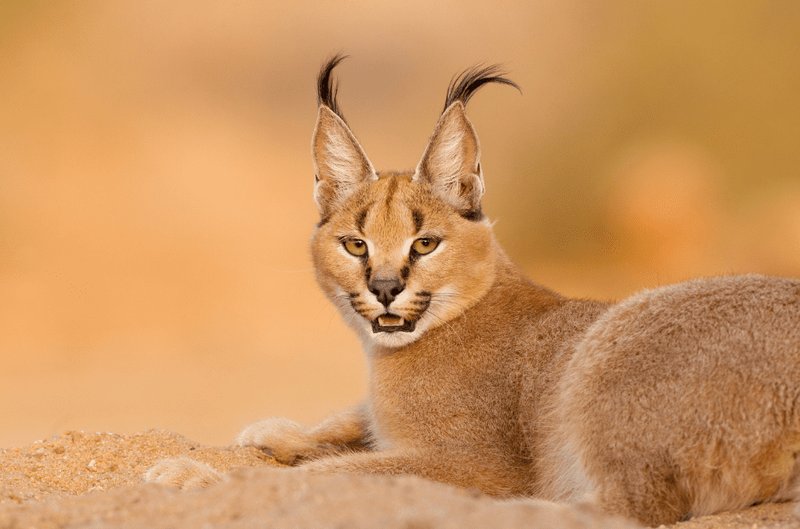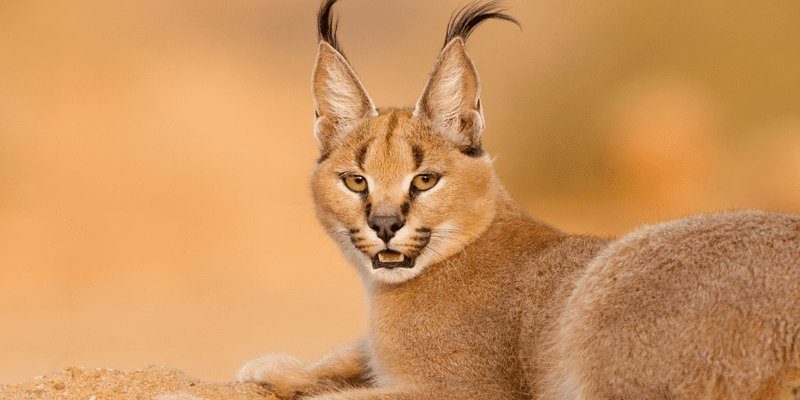
Native to Africa, the Middle East, and parts of Central Asia, the caracal is often celebrated for its stunning looks and unique behaviors. With tufted ears and a compact body, they have an elegance that’s hard to ignore. So, grab a cup of coffee, and let’s dive into ten intriguing facts about the caracal that you probably didn’t know!
1. Those Tufted Ears are No Accident
One of the most striking features of the caracal is its long, black-tufted ears. You might be wondering, “Why do they have those funky ears?” Well, they serve a very practical purpose! The tufts help to enhance their hearing by funneling sound toward their ears. Imagine turning your head to listen closely when someone whispers; that’s what the caracal does naturally.
Moreover, these ears are not just for show. They can rotate independently to pick up sounds from different directions, making the caracal a master at hunting. Whether it’s the rustle of a small rodent in the grass or the call of a bird overhead, the caracal’s ears can catch it all. It’s like having a top-notch sound system built right in!
2. What’s in a Name?
The name “caracal” comes from the Turkish word “karakulak,” which translates to “black ear.” Honestly, that’s a pretty fitting name, given their defining feature. But there’s more to their nomenclature. In various cultures, caracals have been associated with different myths and folklore.
In ancient Egypt, for example, these cats were revered and often depicted in art alongside gods. They were considered symbols of grace and prowess—traits that resonate well with their hunting capabilities. So, the next time you hear the name caracal, think of a creature steeped in history and legend!
3. A Diet of Champions
Caracals are not your average house cats when it comes to meals. These agile predators primarily feast on small to medium-sized animals, including birds, rodents, and even small gazelles. You might be surprised to learn that they are incredibly skilled jumpers, capable of leaping up to 10 feet in the air to catch birds mid-flight. That’s like jumping over a car!
Here’s the thing: their hunting technique is as impressive as their physical abilities. Caracals often employ stealth, stalking their prey before pouncing with incredible speed and precision. They can take down prey that is much larger than themselves, showcasing their strength and skill. So, next time you hear a bird chirping, remember that there might be a stealthy caracal lurking nearby, just waiting for the right moment to strike!
4. The Caracal’s Home Range
Caracals are quite adaptable when it comes to their habitat. You can find them in a variety of environments, from savannas and grasslands to mountainous regions and forests. However, they prefer areas with some cover, like bushes or trees, which help them ambush their prey more effectively.
Their home range can span quite a distance—up to 100 square kilometers for males! This means they have a lot of territory to explore and defend. You might think of it as their personal kingdom, where they’re the rulers, prowling and marking their territory with scent. Talk about keeping up with the neighbors!
5. Masters of Solitude
Unlike lions, which enjoy the company of their pride, caracals are solitary creatures. They prefer to live alone, except during mating season or when a mother is raising her kittens. This solitary lifestyle allows them to be more stealthy while hunting and less competitive for food.
You might find it interesting that they are also somewhat territorial, marking their domain with scent markings and scrapes on the ground. But here’s the thing: being solitary doesn’t mean they’re antisocial. They communicate with each other using a range of sounds, from hisses and growls to meows, especially during mating seasons.
6. Unique Adaptations for Survival
Caracals have several adaptations that help them survive in the wild. For instance, their short coats allow them to stay cool in warm climates, which is essential for an animal that thrives in Africa and the Middle East. Plus, their long legs give them an advantage when sprinting to catch prey.
Interestingly, they also have retractable claws, much like domestic cats. This feature helps them keep their claws sharp for hunting, as they can retract them when they’re not in use. It’s like having a secret weapon that’s always ready!
7. The Caracal’s Breeding Cycle
When it comes to reproduction, caracals have an interesting cycle. Mating typically occurs throughout the year, but it’s influenced by environmental factors, like food availability and habitat conditions. Once a female is ready to mate, she’ll attract males with specific calls and scents.
After a gestation period of about two to three months, the mother will give birth to a litter of one to six kittens. Here’s a fun fact—those newborn kittens are born blind and rely entirely on their mother for warmth and nourishment in those early weeks. It’s a vulnerable time, but the mother is very protective.
8. Caracals and Conservation Status
While caracals are relatively widespread, they face various threats in the wild, including habitat loss and human-wildlife conflict. As human populations expand, their natural habitats are often destroyed or altered, making it difficult for these magnificent cats to thrive.
The good news? Caracals are currently listed as Least Concern by the International Union for Conservation of Nature (IUCN). This means they aren’t endangered at the moment, but conservation efforts are vital to ensure their habitats remain protected. Who wouldn’t want to see these stunning animals continue to roam the wild for generations to come?
9. A Unique Place in the Ecosystem
Every species plays a role in its ecosystem, and caracals are no exception. As predators, they help maintain a balance by controlling the populations of their prey. This is crucial, as an overabundance of small mammals or birds can lead to ecological imbalances.
By keeping these populations in check, caracals indirectly support the growth of vegetation and help preserve their habitats. So, when you think about the caracal, remember that they’re not just beautiful creatures; they’re essential components of their ecosystems.
10. The Caracal in Popular Culture
Lastly, caracals have made their mark in popular culture, though perhaps not as prominently as lions or tigers. You might find them featured in documentaries or wildlife shows, highlighting their fascinating behaviors and hunting skills. Some also appear in books and movies, often portrayed as mysterious and elusive creatures.
But here’s the kicker: due to their striking appearance and unique characteristics, some people have even kept caracals as exotic pets. However, this isn’t recommended, as they require specialized care and a lot of space to thrive. Ideally, these incredible felines should remain in the wild, where they can roam freely.
In conclusion, the caracal is a captivating cat that deserves more attention. From their tufted ears to their impressive hunting skills, they truly stand out in the animal kingdom. So next time you hear about big cats, don’t forget about the remarkable caracal and the vital role they play in their environment. They’re more than just a pretty face—they’re a symbol of nature’s incredible diversity!

